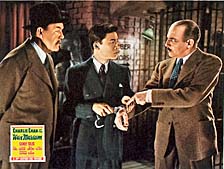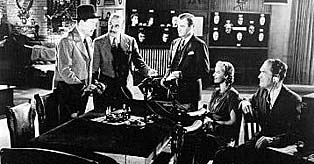Wed 13 Jul 2016
A Movie Review by Jonathan Lewis: CHARLIE CHAN AT THE WAX MUSEUM (1940).
Posted by Steve under Mystery movies , Reviews[3] Comments
CHARLIE CHAN AT THE WAX MUSEUM. 20th Century Fox, 1940. Sidney Toler, Victor Sen Yung, C. Henry Gordon, Marc Lawrence, Joan Valerie, Marguerite Chapman, Ted Osborne. Based on the character created by Earl Derr Biggers. Director: Lynn Shores.
There are enough plot holes in the movie that not even a top-notch police detective from Honolulu could easily solve. And it’s true that the acting talents on display here aren’t all that memorable. But Charlie Chan at the Wax Museum is nonetheless a spunky little programmer and, in my estimation, a particularly well photographed entry in the Charlie Chan series. The art direction is likewise top notch and serves the film well.

The plot: Notorious gangster Steve McBirney (Marc Lawrence) escapes from police custody and seeks refuge at a crime-themed wax museum. The proprietor, Dr. Cream (C. Henry Gordon), who doubles as a plastic surgeon capable of giving escaped convicts new faces, invites Charlie Chan (Sidney Toler) to the museum.
Although he and McBirney (Lawrence) are plotting Chan’s demise, he cajoles Chan to visit to take part in a live radio broadcast where Chan and Dr. Otto Von Brom (Michael Visaroff) can debate a controversial past criminal case.
So, on a dark and stormy night, Chan and a hodgepodge crew arrive at the museum for the broadcast. Among them are an intrepid reporter, Mary Bolton (Marguerite Chapman); a radio announcer and his broadcast assistant; Dr. Cream’s assistant; and an attorney. Things seem to be going okay for the group. That is until someone cuts the lights (of course they do!) and Dr. Von Brom ends up dead.

It’s then up to Chan, along with bumbling son Jimmy (Sen Yung) to solve the mystery. Who killed Von Brom and why? Was it McBirney, who is hiding out in the museum? Or maybe one of the wax dummies isn’t a dummy after all and is really alive? Or could it be someone else?
As I mentioned earlier, there are more than a couple of plot holes in the story. Still, it’s not so much the destination as the journey itself that makes the movie worth a look. What struck me watching Charlie Chan and the Wax Museum is how much the Charlie Chan universe has its own particular rules that guide how both criminals and frightened individuals behave.

When it comes time for Chan to solve a crime, for instance, he somehow is able to gather all the suspects in the same room with a mere wave of his hand, which may or may not be holding a small pistol. Suspects cower on cue and they nearly always comply with his commands.
And despite the vicious crimes committed on or partially off screen, the Charlie Chan cinematic universe is a rather innocent world in which the players simply don’t ever come across as truly evil. Perhaps this partially explains why the Charlie Chan universe simply was no longer palatable to cinema-goers in the wake of the Second World War. Soon enough, seedy neon lit bars and dingy hotel rooms would replace wax museums and circuses as the predominant locales of far more cynical crime stories in what would later be termed film noir.
July 14th, 2016 at 3:52 am
As you noted, logic as never a strong suit in the Chan films, but they had their moments and you gave this one its due.
July 14th, 2016 at 10:05 am
I think the pre-war Charlie Chan movies epitomized exactly what movie audiences wanted in mystery movies at the time. And because of their continuing success, movie producers kept giving them more and more of same kind of movies, by which I mean a little more comedy than was needed, and not nearly enough in terms of actual detective work.
July 19th, 2016 at 1:47 am
Not the best of the series, but atmospheric and fun in the noncritical way you have to watch these. The series was starting to creak here but still had solid production values and Toler in good form with a cast of pros.